Ever since discovering John Company Second Edition and Carnegie, I’ve become interested in board games that have some historical foundation. While Carnegie was merely inspired by the name-giving philanthropist and has little resemblance of the actual, complex and controversial person that was Andrew Carnegie, both games inspired me to buy books on their topics and dive deeper into them.
In contrast, I’ve never been interested in the historical conflict/war-gaming category of games and still remain not so. Even lighter titles like Watergate failed to keep my interesting for long and I happily traded it away for a copy of Sagani, which is arguably the worse game of the two. But the unique topic of Votes for Women had me intrigued for a long time and so I finally picked up a copy a few weeks ago.
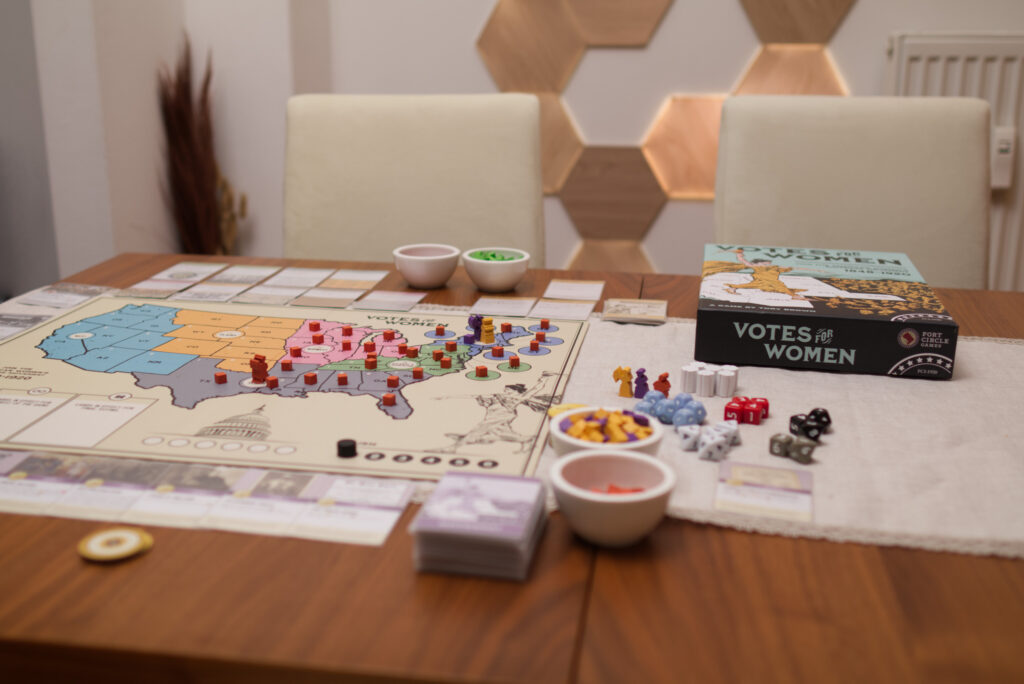
Setup
Opening the box of Votes for Women, players find a rather bland looking board showing the 48 states of the contiguous Unites States, split into 6 regions with 8 states each. There is no initial seeding or setup needed as it will largely happen via starting cards the players can play on their actual turn. Setup primarily consists of one player taking the Suffragist and the other the Opposition deck, splitting the cards into their three eras of early, middle, and late, giving each a good shuffle and then stacking them on top of each other. Both players also have a single card marked as “start” that goes in their initial hand. Three so called strategy cards (extra free actions) will be revealed in a market display as well as 9 (out of a total of 12) key state cards. The rest is just pouring out some ziplock backs and creating supplies of cubes and various other components.
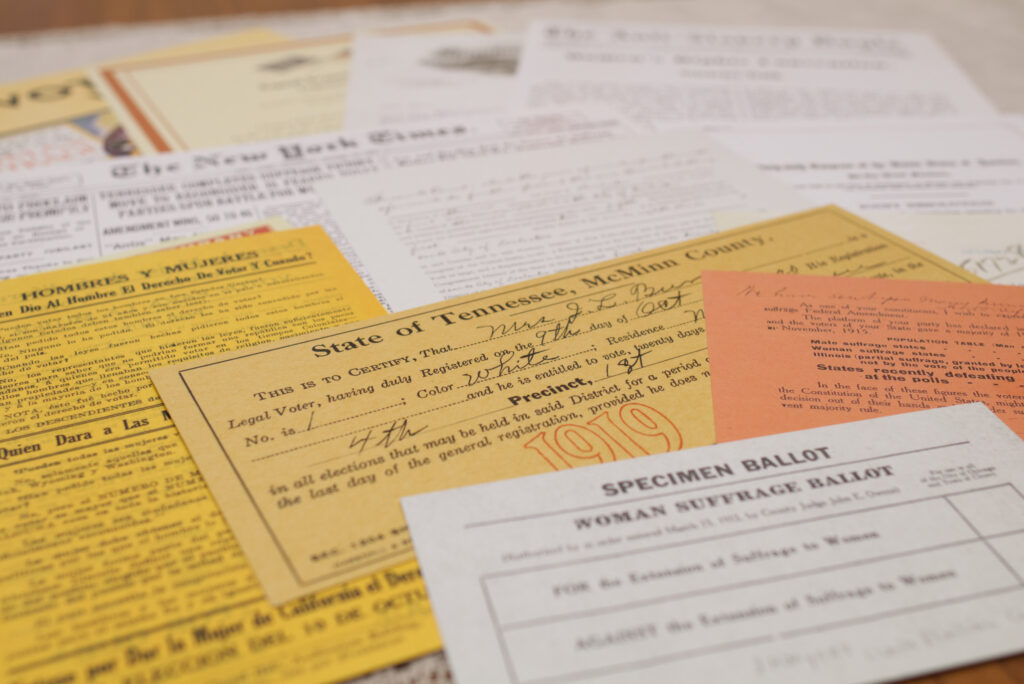
While players are at liberty to play any card as their first card, it usually makes sense to begin with the start card which in the case of the Suffragist player places to meeples called campaigners into the North-East region and places two of their cubes into the state of New Your. For the opposition player, the start card places on campaigner into the South region and pre-fills four whole regions (so 32 states total) with one of their cubes each.
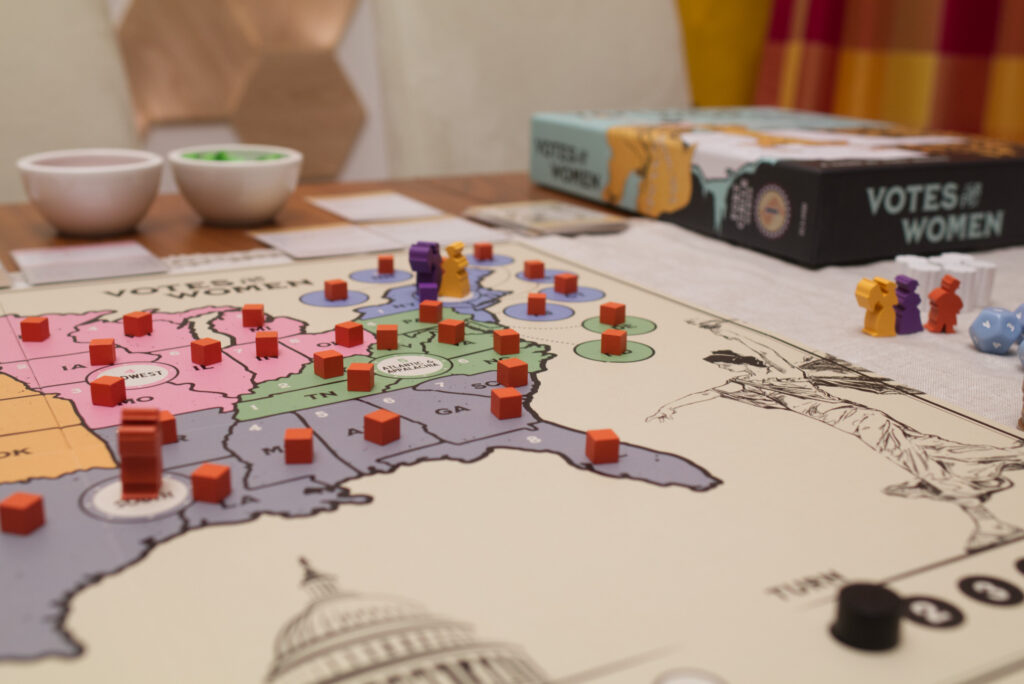
The Turn
Votes for Women is played over a maximum of 6 turns with 6 rounds each. Weirdly enough, the game uses the terms “turn” and “round” in the opposite way most games do, so sorry in advance for any subsequent confusion. The aim of the Suffragist player is to bring the 19th amendment (granting the right to vote regardless of sex) to congress and then getting 3/4 of the states to ratify it. The Opposition wins if either time runs out without the Suffragists getting the 19th amendment to congress – or – if they win 13 states for their side, denying the Suffragists the required number of states. The magical number here is four: four cubes are needed AFTER the 19th amendment has been passed by congress to decide a state. Four is also the number of cubes needed in one of 9 key states to win its state card and thus receive the free one-time action printed on it.
The turn starts with each player drawing 6 cards from their deck to bring their hand to a total of 7, which is called the Planning phase. They then invest campaign buttons (the currency of the game) to get one of three strategy cards currently on display as part of the Strategy phase. This isn’t an auction though: The Suffragist player has to announce how many buttons they want to invest and those buttons are gone, regardless of whether they will get a card or not. The Opposition player then can either spend no buttons and let them have the card, spend an equal amount so nobody gets anything, or exceed the Suffragist player’s number to get a a strategy card themselves. Strategy cards are kept face up in front of the player as a one-time free action until they want to use it. These can range from quite powerful (like drawing 6 cards, playing one as a free action and then deciding which of the rest should stay on top of the draw deck or should go to the bottom) to rather weak (like gaining two buttons). Both key state and strategy cards can be played in addition to a players regular action, but only one of them per round (=one card action).
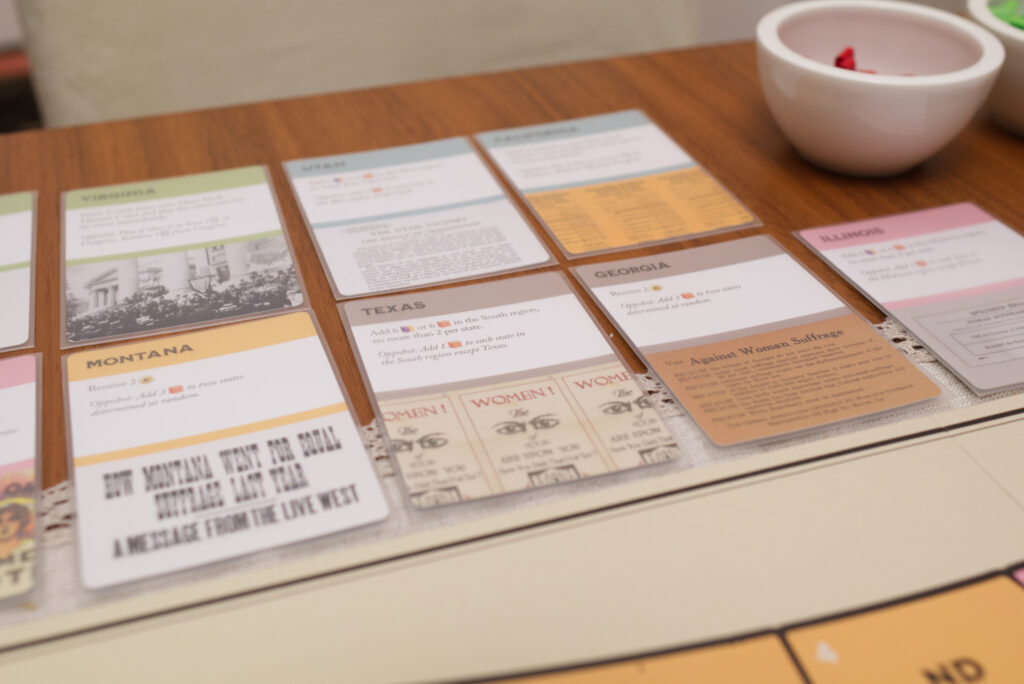
The core of the round … aah … turn though is the Operations Phase where first the Suffragists play one card, then the Opposition, and then both continue in this fashion until 6 cards each have been played, leaving one card to be carried over to the next round.
Each card can be used for one of four actions: play the card as an event (=following the instructions printed on the card), discarding it to roll dice and generate votes on the map based on the number and locations of campaigners they have (“campaign”), gaining buttons equal to the number of campaigners they have (“organise”), or as an act of desperation role D6s to place column pieces on the board for each 6 they roll (“lobby”). These represent the 19th amendment being passed by Congress. Once all 6 spots on the board are covered by columns, every state with four or more cubes gets replaced by either a green check mark or a red cross to indicate the winning side. As long as neither side has reached their required number of states, the game continues and whenever a state reaches four cubes, again they are replaced by a check mark or cross.
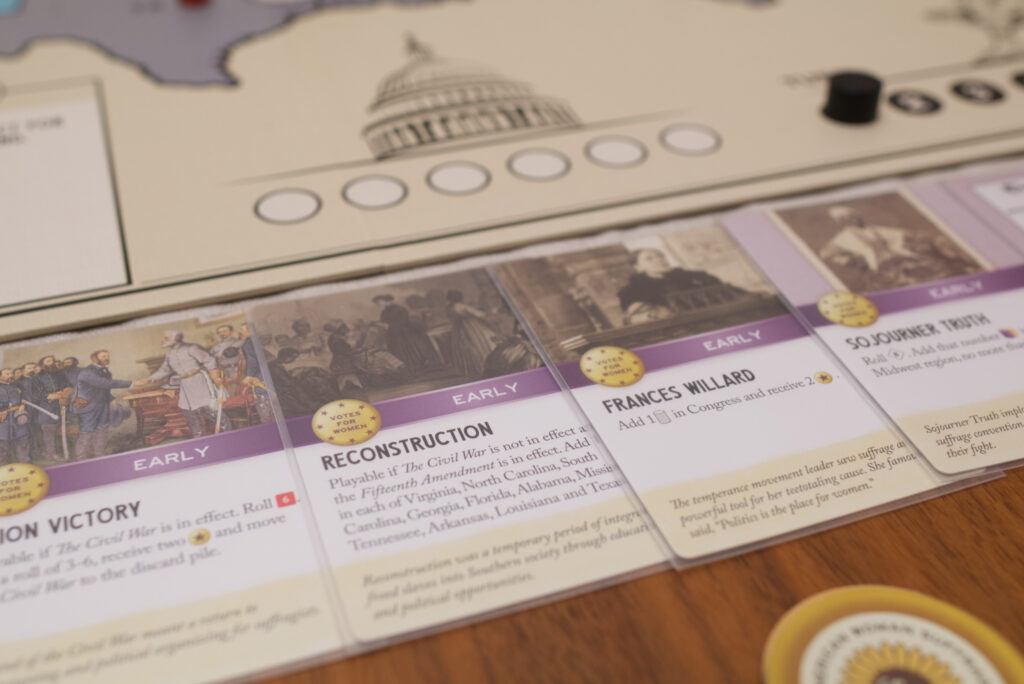
Most cards allow the player to place cubes in various states or regions, fewer add/remove columns, and even fewer provide/cost campaign buttons to do some effect like searching through the deck to pull a specific card). There are also three types of persistent cards: those that affect the current turn (remember: whole round), stay permanently, or affect the final vote which we’ll talk about later. Examples of these are modifiers that increase the power of the campaign action or causing a player to have to spend a campaign button whenever they want to use a card for its effect. Overall, a lot of the card play feels very repetitive: play a card, add cubes – or if the other side is controlling a state reduce their number of cubes by the same amount. I encountered multiple situations where I had three cards with all the same function of place one 1 cube per region on it on my hand.
Note: the Suffragist side consists of both yellow and purple cubes which are for most purposes exactly the same. They are simply representing that the Suffragist movement wasn’t uniform in opinions and a few cards of the opposition target one colour specifically (e.g. remove all yellow from 2 states). In general, the Suffragist player will want the distribution to be as even as possible whenever they have a choice.
Where things get interesting are the permanent effect cards. These represent key decisions or historical events like the civil war. The pattern here is always the same: one player can play a certain event to get an immediate substantial benefit that makes it attractive to do so. However, there is a “counter card” in the opponent’s deck that ends the event and provides an also substantial bonus. For example: the Suffragist player can decide to support the 15th amendment (granting African American Men the right to vote) which has positive effects for the movement itself but gives the Opposition fodder to exploit. So the calculus is to either play the card and hope the other side will take a long time to draw the counter part – or – carry it over to a later turn when the opponent has already discarded the counter card. It has touches of a mind game, but not a big one.
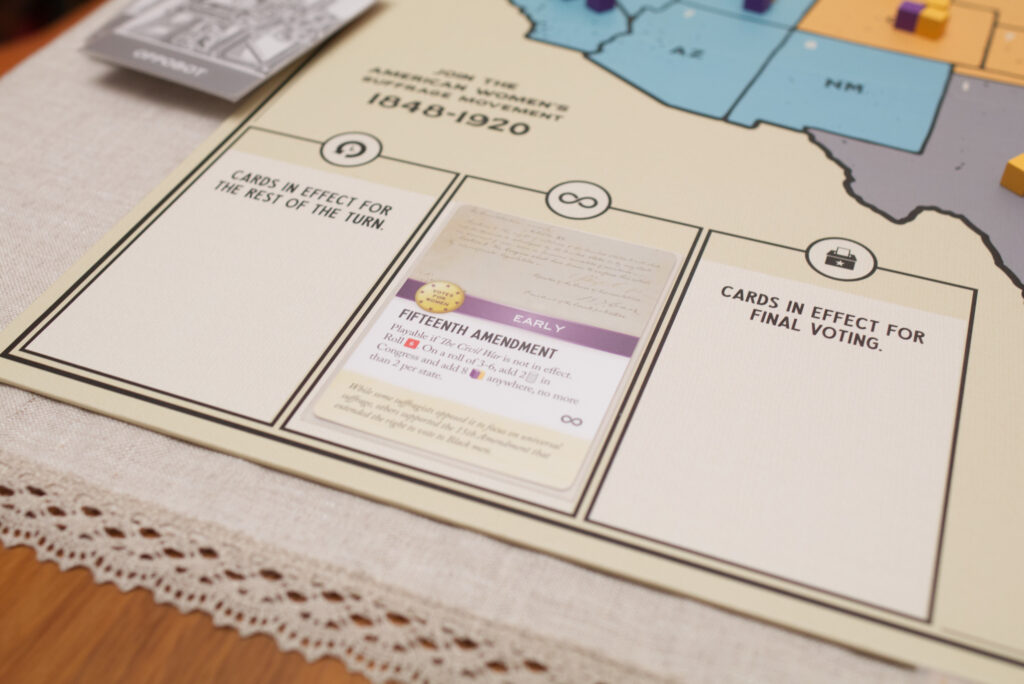
What is more consequential is that there are certain action cards, key state cards, and strategy cards that allow a player to draw more cards or mill through their deck faster. Since later cards are typically more powerful than middle cards, and middle cards are more powerful than earlier cards, getting through the deck quicker can have positive effects. But it can also lead to players skipping cards they might need as a counter to something the other player does. For example, I once as the Opposition drew a hand that almost exclusively consistent of cards that removed columns but the Suffragist player never placed a column in that turn.
There are a few more rules like the possibility to spend a button to re-roll a dice roll or move a campaigner, but overall, that’s pretty much it.
End of Game
The game can end in three ways: 1) the Opposition wins because the Suffragists don’t even get congress to pass the 19th amendment before the end of the 6th turn (=the 6th column was placed), 2) congress passes the 19th amendment and one of the sides has won their required number of states early (ending the game immediately), or 3) congress has passed the 19th amendment but neither side has reached the required number of states. In that case, the Final Voting is triggered where states are rolled for: each player rolls a D6 (unless modified through some permanent card effect) adds the number of cubes if they have any in that state, and the higher number wins. By default, the Opposition wins on a tie but there is another permanent effect card that flips this to the Suffragists.
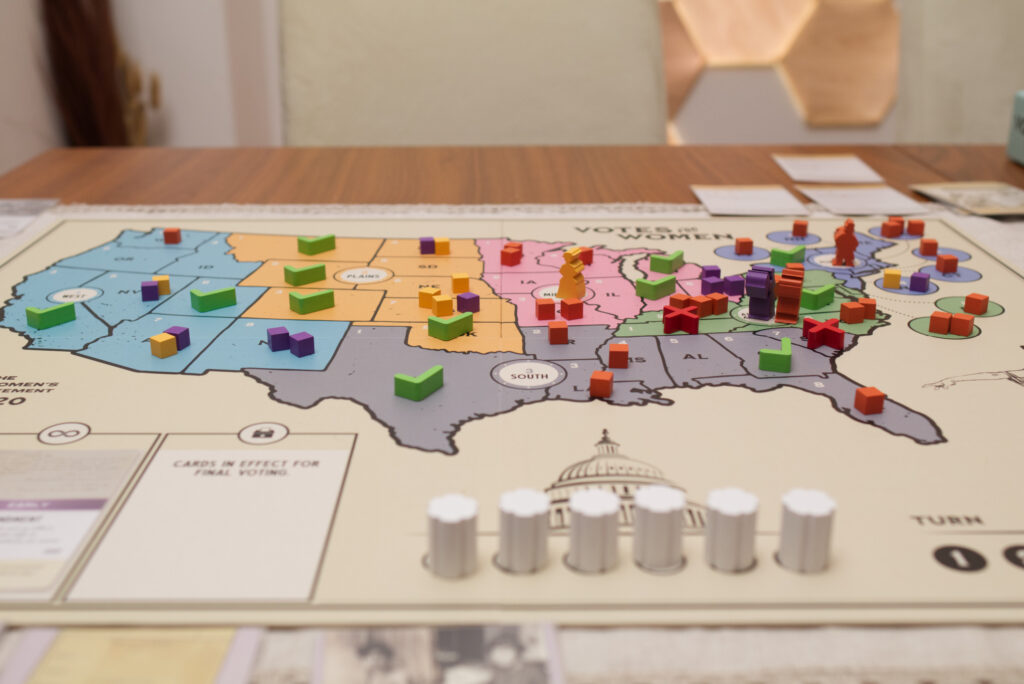
Solo Mode and Team Play
In Solo Mode, the human player has to play the Suffragist side and the Opposition is replaced by a separate card deck called the Oppobot. Whenever it’s the Opposition’s turn, simply reveal the top card and follow its instructions. There are 3 special cards that are played as first card on turn 1, 3, and 5. That’s pretty much it. There are a few rules to manage which state the Oppobot will place votes in and so on, but overall the rules overhead is quite small. A nice twist is: during setup, two cards of each era (early, middle, later) are removed face down from the Oppobot’s deck so the human player can’t be sure if certain permanent effects will actually come into play or not. For increased difficulty, certain dice can be replaced with higher value alternatives (e.g. a D4 that has more faces showing 4s), making the Oppobot for example more competitive when bidding for strategy cards.
In general though, I felt the automa provided an okay but somewhat lacking experience. It’s quite easy to get all 6 columns out by waiting for it to skip some “remove column”-cards and in most games I was able to prevent it from getting ANY of the key state cards. So it’s good that the automa is there and I enjoyed playing against it. But beyond the discovery phase while learning the game, I don’t see it as a good replacement for a human player.
There are also variants to play as two players against the Opposition and for team vs team play, but I haven’t tried these and thus cannot really comment on then. Let’s just say I have no intent to actually try them out.
Conclusion
Votes for Women is one of those games where it can be argued whether it is more a game or more an experience. From the outset, Votes for Women starts off with a lot of points in its favour: a very unique and interesting topic, nice production with historical material, and a rather concise ruleset – though the rules themselves are written in a unusual fashion and certain information was stuck in places other than the ones where I would have expected them. This made referencing things during rules questions surprisingly hard. So learning the game was more painful than it needed to be but teaching Votes for Women is super simple.
On the downside, Votes for Women has a rather linear narrative with few key decision points, fairly repetitive card functions, and a huge amount of randomness both in the order of how cards are drawn as well as in the die rolls. I can best describe it in that while you’re paying for a $50+ game, its depth feels more like a $20 card game with a really nice production and a lot of attention to detail put on top of it. Players focus on key states to win free actions during early game, try to have enough buttons to win strategy cards, and decide on whether or not to play the powerful permanent effect cards … but otherwise it’s a lot of die rolling and hoping for a good hand of cards. While it’s interesting to have to decide which card to strategically carry over to the next round, the effect of that is far outweighed by the randomness of the die rolls. Still, one can argue that it’s a card driven dice chucker and fun at what it is, and that is very much so. I’ve greatly enjoyed making myself a cup of tea and spending an hour with Votes for Women, seeing how things will play out. But the story that is playing out is always the same and – even more consequential – I’m not an actor in it.
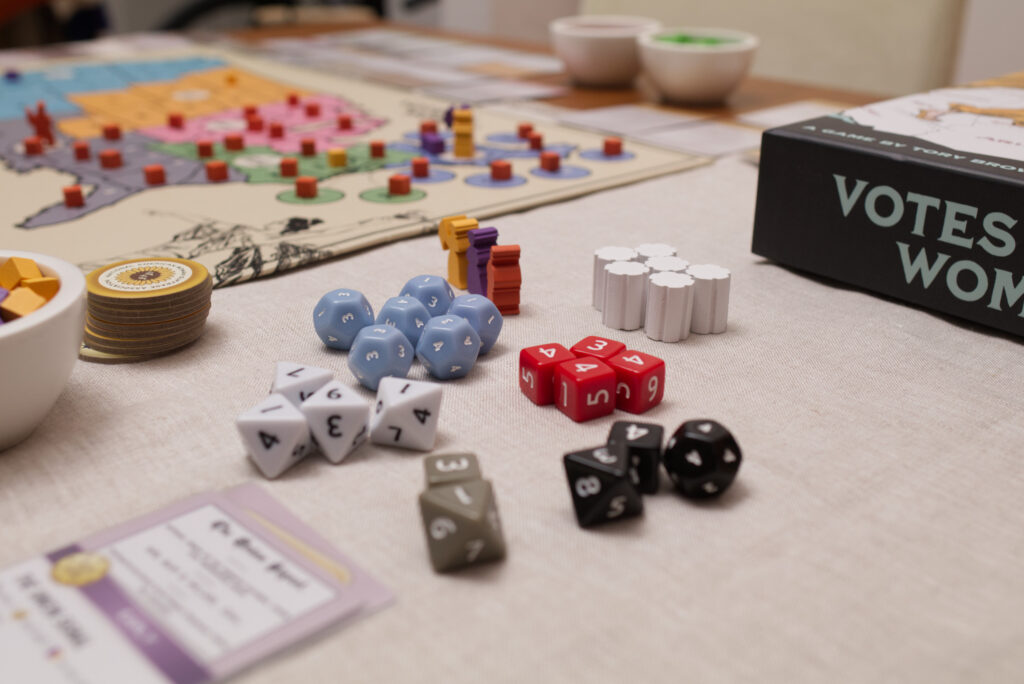
The brilliance of John Company Second Edition is that the players step into the shoes of the various office holders of the company and each time face a different India. Sometimes there are revolts, sometimes huge empires prosper in peace. One time a storm sinks ships at the most inopportune time and as a result brings the company to the brink of bankruptcy, the next time it’s flush with money and pays dividends. While JC2e re-tells the same history of the East India Company every time, the story it tells with each play is new. And most importantly, the players are forced to inhabit the characters of those that led to the colonisation of a whole sub-continent. Human life becomes secondary to earning enough money for buying fancy houses, moral dilemmas are thrown out of the window for short term profit, and negotiations are often screwing over former partners. It is equally appalling and fascinating to walk in those shoes.
In contrast, in Votes for Women the players are not really embodying anybody, neither a key figure nor the one abstract organiser of the movement. We are players playing cards. How much more powerful a message could the game have had if players would have slipped into the role of a single Suffragist or opposing senator? It also suffers from a similar fate to Nemo’s War: as lovely as the art and flavour texts are, players quickly skip over them and simply see the cards as abstracts that place or remove cubes and columns. I couldn’t name a single senator or key figure of the Suffragists even after having played the game more than ten times by now. In many aspects, it feels like the game is catering towards people that are already invested in its topic. A highlight real of names that never substantiates into a relatable person. Also it seems to assume the audience is American. A lot of cards name specific states without any hint where they are and the main board shows only the two letter state abbreviations. As a non-American, it took repeated googling to for example figure out if Missouri is abbreviated as MI, MO, or MS (it’s MO by the way). And even if you know that, the abbreviations are quickly hidden under all the cubes placed into the various states. For example, try to find the state of Maryland in the image below.
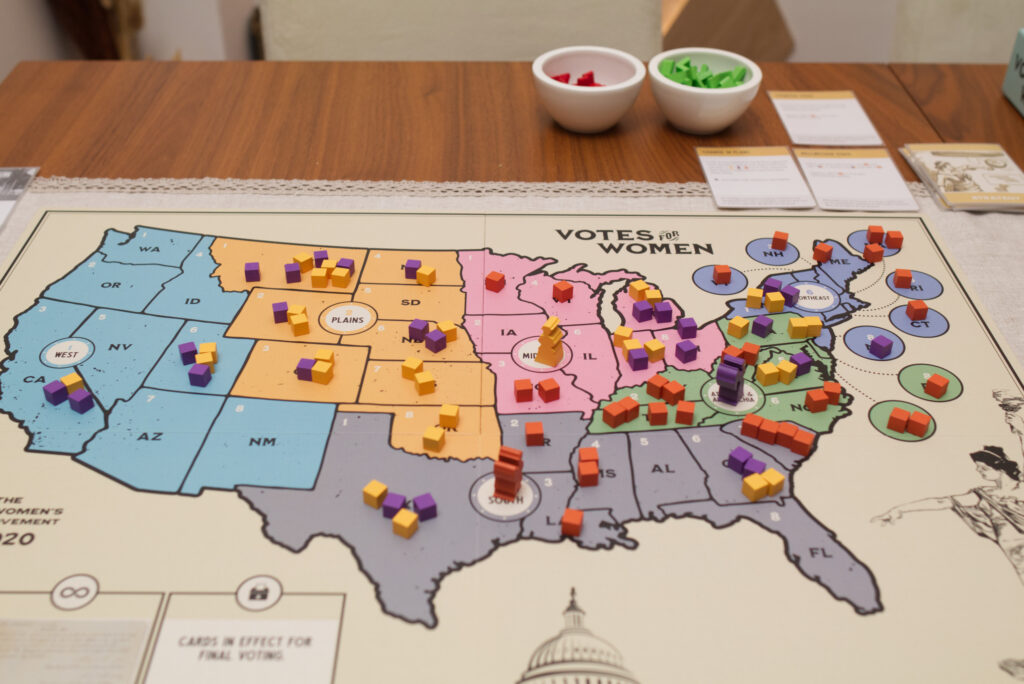
I can best sum it up as follows: Votes for Women is like a great book everybody should read once. If they will want to re-read it is a different question. I’m super happy that it manages to shine a spotlight onto this important part of history and celebrates the members of the movement that had to suffer tremendous blowback and personal sacrifices. But it’s not a book I plan to re-visit anytime soon, or perhaps ever again. As much as I support what author Tory Brown and publisher Fort Circle Games are doing here, purely seen as a game, there are other entries in this category that seem to have more longevity. I’ve recently started playing Shores of Tripoli (also be Fort Circle Games) which’s mechanisms in many aspects are not as refined as those of Votes for Women. Despite that, I think I enjoy Shores of Tripoli more because the dice chucking – as infuriating as it might be sometimes – matches more its theme. The aforementioned Watergate doesn’t have dice rolling and so doesn’t compare directly, but its card mechanism has a ton of replayability. A friend also commented that he felt Votes for Women seemed somewhat similar to 1960: The Making of President (which he preferred) and Twilight Struggle would offer better card play. I cannot comment on those myself because I haven’t played them and currently have no intend to do so. That’s where Votes for Women has them beat: it has a very appealing topic and the ruleset is super approachable. So give it a try if you have the chance. It’s a very nicely executed experience, I’m just not as enamoured with it as a game.
